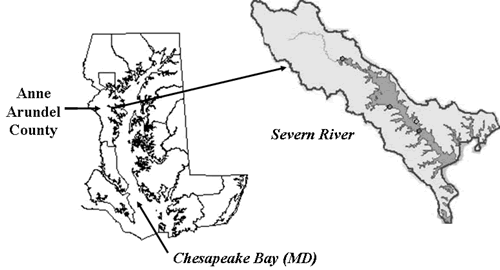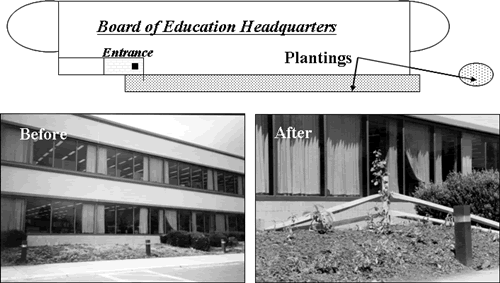February 2007 // Volume 45 // Number 1 // Ideas at Work // 1IAW5
Seeking Environmental Stewardship One Garden at a Time
Abstract
Master Gardeners and teachers in Anne Arundel County MD partnered to give hands-on educational experiences promoting environmental stewardship, how we treat the environment when nobody is watching. The partnership supports and teaches ecological reconciliation by building and caring for 4964 ft2 (1578 m2) of native plant gardens. This reproducible project encourages environmental stewardship without rhetoric, one spadeful at a time.
Introduction
| "As our activities continue to exert an increasing impact on the environment . . . basic ecological principles will become all the more crucial to . . . life." |
| Ricklefs, 1976 |
We offer a model program for partnering local Extension with the local school system. How does a teacher get social studies and science woven into the curriculum? Our way combines hands-on learning with outdoor experiences and teachers using innovative ways to involve students. Students learn best with their senses and physical activity centered in their environment (Montessori, 1964). In the Chesapeake Bay region of Maryland, this involves learning about the Bay, its problems, and constructive ways to solve these problems. The most common problem is excess nutrients (Leonard, 1999).
Extension Master Gardeners joined with county public school educators to develop a model hands-on learning program. Our goal was developing environmental stewardship. We involved teachers, students, and parent volunteers from various schools with Master Gardeners to demonstrate how to return a "disturbed" area to a more natural state with native plants (Rosenzweig, 2003). Our umbrella program is Chesapeake Connections. It connects classroom curriculum with hands-on learning, teaching students, teachers, and area citizens proper landscaping. We use native plants, and provide an opportunity (DeMarco, Relf, & McDaniel, 1998) to:
- Experience hands–on learning;
- Develop positive social qualities;
- Encourage appreciating nature;
- Improve learning and social achievement in a relaxed, interesting setting; and
- Show a way to reduce nutrients going to the Bay.
Our area of concentration is the Severn River watershed (Figure 1). What we teach is:
- Replacing plants needing intensive fertilization in gardens with plants needing little fertilization;
- Reducing water use through the proper plant placement; and
- Using healthy soil additives (compost).
Emphasis is on demonstrating landscape management techniques that reduce nutrients and soil erosion. In addition, we encourage:
- The exercise quality of gardening;
- A sense of accomplishment; and
- Socialization skills.
Figure 1.
Location of Study Area

Methods
We ask each student to commit to:
- Understanding the environment;
- Having an interest in how nature works; and
- Learning how to keep the environment healthy.
To promote the learning objectives, we build small native plant gardens at the Arlington Echo Outdoor Education Center (AEOEC) in Millersville, MD, and at the Board of Education (BOE) in Annapolis, MD. This is stewardship through action. At both sites, we have plantings for full sun, partial shade, and full shade.
At the sites, the gardens went into existing areas. The plantings included:
- Removing exotic and invasive plants;
- Taking soil samples;
- Making a design;
- Preparing the soil; and
- Conditioning the plants to resist grazing.
Except for initial tilling, all work was by students using hand tools. Elementary School (K, 1st, 2nd, and 5th), Middle School (8th grade), and High School (Special Education) students participated. Over 2 years, our program directly educated 500 students, 23 teachers, and 50 parents. This program was self-supported with grants from the National Oceanic and Atmospheric Administration, The Chesapeake Bay Trust, and Unity Gardens. We determined impacts from an attitude survey (BOE), teacher project review, and program cost savings. Results were presented to external professional groups and awards received.
Results
We planted 1364 ft2 of AEOEC beds (Figure 2) with 243 (5 groups) native plants. At the BOE, we planted 3600 ft2 with 769 (5groups) native plants (Figure 3). Table 1 is an impact summary. The program is reproducible; more schoolyard projects are developing.
Figure 2.
AEOEC Landscaping and Results

Figure 3.
BOE Landscaping and Results

| Impact | Organization | Result |
| Student Survey | County Schools | 94% acceptance and learning |
| Master Gardener Support (1 man-year of effort) |
County Extension | Estimated savings to school system- $19,300.00 |
| Installation Cost Savings
to School System (grant support) For 2 gardens @ 0.11 acres |
County Extension | Estimated savings of $11,500.00 |
| Garden Savings to School System Maintenance (0.11 acres) | County School Maintenance | Estimated savings of $220.00 for a season |
The submission of our program for external recognition resulted in one international, three national, and one state award for "innovative program."
To ensure future success, we received the use of the greenhouse facilities at the North Technical High School (AACty) to teach 5th and 8th graders how to grow and maintain native plants. These plants are grown from seeds harvested from this program. Plants are used to support new garden start-ups at other schools. Currently, the gardens are maintained year round by students (part of outdoor education curriculum), and the special education program at an area high school.
Conclusions
These gardens met the following objectives:
- Established native plant demonstration gardens at two central locations;
- Created continuing learning experiences from growing native plants in school greenhouses to actual development, design, installation, and maintenance of the gardens;
- Created a learning site for public outreach;
- Created demonstrations on proper landscaping techniques;
- Saved the county schools money in set-up, personnel, and maintenance costs;
- Taught students environmental stewardship; and
- Promoted a lasting partnership between the public schools and the Master Gardener program.
Finally, we addressed the needs of the Chesapeake 2000 Interstate Agreement (Anon., 2000) to:
- Preserve, protect and restore habitats;
- Offer a solution for reaching the public;
- Achieve and maintain water quality;
- Present a constructive way to limit nutrients while beautifying property; and
- Promote individual stewardship.
Our project encourages the development of stewardship without great expense. Native plants are best management practices. Students who learn in an outdoor environment can improve their environmental attitudes (Skelly & Bradley, 2000). Our reproducible project encourages environmental stewardship without rhetoric, one spadeful at a time.
| "The secret of good teaching is to regard the child's intelligence as a fertile field in which seeds may be sown." |
| Montessori (2005) |
References
Anon. (2000). Available at: http://www.chesapeakebay.net/agreement.htm
Anon. (2005). Available at: http://www.learningcirclemontessori.org
DeMarco, L., Relf, D., & McDaniel, A. (1998). Extension Master Gardeners valued by teachers in school gardening programs. Journal of Extension [On-line], 36(5). Available at:
http://www.joe.org/joe/1998october/a5.html
Leonard, B. (Ed.) (1999). State of the Chesapeake Bay: A report to the citizens of the Bay Region. Collingdale PA: Diane Pub Co.
Montessori, M. (1964). The Montessori method. Amsterdam: Schocken Books. Inc.
Rosenweig, M. (2003). Win-win ecology. New York: Oxford U. Press.
Ricklefs, R. (1976). The economy of nature. Portland OR: Chiron Press.
Skelly, S., & Bradley, J. (2000). The importance of school gardens as perceived by Florida elementary school teachers. Horttechnology. 10(1):229-231.
